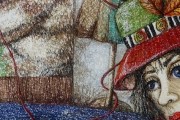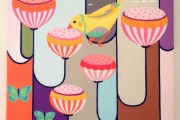 One of the most enjoyable aspects of art is anticipation. I have been waiting to view Nicholas Folland’s latest installation at the Art Gallery of SA for some time. As I understand it there was a considerable amount of engineering required to hang this majestic sculpture. It is titled “Jump up” and initially eluded me as it is displayed away from the other Biennial works.
One of the most enjoyable aspects of art is anticipation. I have been waiting to view Nicholas Folland’s latest installation at the Art Gallery of SA for some time. As I understand it there was a considerable amount of engineering required to hang this majestic sculpture. It is titled “Jump up” and initially eluded me as it is displayed away from the other Biennial works.
The development of this work is centred on the Mediterranean Island of Thera or Santorini as it is now known. This place is rumoured to be the actual location of the mythical city of Atlantis, which was described by Plato in his Critias (one of his late philosophical dialogues). It was in his words an advanced city, a miraculous place. What ever existed on this island prior to 1500 BC was brought to an abrupt end by a cataclysmic volcanic eruption that blew the place apart.
 Hundreds of glass objects; bowls, goblets and cake platters are grouped to resemble a floating land in the shape of the island of Thera. The work has a flat base and is suspended tenuously by thin wires; it seems to float above the parquetry floor of the gallery in a cloudlike and unassuming fashion. For me, it resembles the rock formations in a Zen garden. It is quiet and bold and invites contemplation. The visual weight and fluctuating textures provide the viewer with an entrancing sculpture. Most people have mental associations with the glass objects used in its construction; they have a certain familiarity that engages the viewer on a different deeper level. They are artifacts of the past that may once have lived a life as an old wedding gift, or memorable trinket. These treasured items may have been tucked away in the back of a dark cupboard before inevitably finding their way to an Op Shop. Rescued and reformed by Folland they now live a new existence. As you navigate around the island of glass you can see many colonial works from Australia’s early settlement. This provides us with a clue as to why this particular work is found here in Gallery 3 with the colonial art and not with other works in the Biennial exhibition.
Hundreds of glass objects; bowls, goblets and cake platters are grouped to resemble a floating land in the shape of the island of Thera. The work has a flat base and is suspended tenuously by thin wires; it seems to float above the parquetry floor of the gallery in a cloudlike and unassuming fashion. For me, it resembles the rock formations in a Zen garden. It is quiet and bold and invites contemplation. The visual weight and fluctuating textures provide the viewer with an entrancing sculpture. Most people have mental associations with the glass objects used in its construction; they have a certain familiarity that engages the viewer on a different deeper level. They are artifacts of the past that may once have lived a life as an old wedding gift, or memorable trinket. These treasured items may have been tucked away in the back of a dark cupboard before inevitably finding their way to an Op Shop. Rescued and reformed by Folland they now live a new existence. As you navigate around the island of glass you can see many colonial works from Australia’s early settlement. This provides us with a clue as to why this particular work is found here in Gallery 3 with the colonial art and not with other works in the Biennial exhibition.
 In writing about this work Folland makes the statement, “miraculous places can and do exist”. Now indeed we are transported into the world of thinking that the early colonials must have experienced. This new world was often described as the antipodes to early Europeans. The word literally means “feet on the other side”, an opposite point of view. Australia to them was a land that possessed tremendous potential. Early migrants were brave and intrepid. Australia was an island filled with animals and people who did not fit with the 1800’s scientific paradigm. It was a new horizon, a new start and for many a place where their imaginations could take flight. Most of the works that surround this sculpture depict the nature of Australia as an island continent. For many of the early settlers and their families there was an arduous trek across the world by ship. A trip that held as much danger as the new land they were soon to enter.
In writing about this work Folland makes the statement, “miraculous places can and do exist”. Now indeed we are transported into the world of thinking that the early colonials must have experienced. This new world was often described as the antipodes to early Europeans. The word literally means “feet on the other side”, an opposite point of view. Australia to them was a land that possessed tremendous potential. Early migrants were brave and intrepid. Australia was an island filled with animals and people who did not fit with the 1800’s scientific paradigm. It was a new horizon, a new start and for many a place where their imaginations could take flight. Most of the works that surround this sculpture depict the nature of Australia as an island continent. For many of the early settlers and their families there was an arduous trek across the world by ship. A trip that held as much danger as the new land they were soon to enter.
Nicholas Folland has constructed a salutary piece that is fresh in its approach and complementary to the surrounding colonial works. It certainly caused me to think differently about early colonial art.



